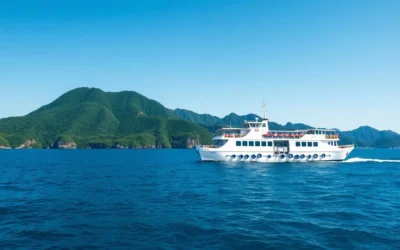✓ Accommodations ✓ Flights ✓ Rental Cars
Planning a trip to Okinawa requires understanding its unique weather patterns. Composed of over 160 islands, this tropical paradise offers diverse experiences throughout the year.
As you prepare for your travel, you’ll discover that each season brings a different experience. From cherry blossom viewings in spring to tropical beach weather in summer, time your visit right to make the most of your trip.
This comprehensive guide will help you identify the best time to visit based on your weather preferences and activities. By understanding the climate variations, you can pack accordingly and enjoy your travel experience in this beautiful island place.
Understanding Okinawa’s Unique Climate
The Okinawan archipelago boasts a unique climate that sets it apart from the rest of Japan. With about 160 islands, including famous areas like Okinawa Honto, Kerama Shoto, Kumejima, Miyako Shoto, and Yaeyama Shoto, the region’s geographical diversity contributes to its distinct weather patterns.
Geographical Overview of the Okinawan Archipelago
The Okinawan archipelago is characterized by its turquoise seas, golden beaches, and colorful reefs. Naha and its surrounding islands exhibit a tropical climate, with an average yearly temperature of 73.4°F (23.1°C). The islands’ position between the East China Sea and the Pacific Ocean significantly influences their climate, creating unique conditions that affect marine life and vegetation.
Subtropical Climate Patterns Year-Round
Okinawa’s subtropical climate means that the region experiences warmer temperatures year-round compared to mainland Japan. Unlike the four distinct seasons in most of Japan, Okinawa’s weather pattern remains relatively consistent throughout the year, with subtle variations across different regions and island groups. Understanding these climate patterns is crucial for planning your visit to different areas of Okinawa.
Key aspects of Okinawa’s climate include its subtropical nature, with higher humidity and warmer temperatures than other parts of Japan. The region’s climate is influenced by its geographical position, creating unique weather conditions that are worth understanding for a well-planned trip.
Seasonal Weather Patterns in Okinawa
As you plan your trip to Okinawa, it’s essential to grasp the seasonal weather variations. Okinawa’s subtropical climate means you’ll experience four distinct seasons, though they differ significantly from those in mainland Japan.
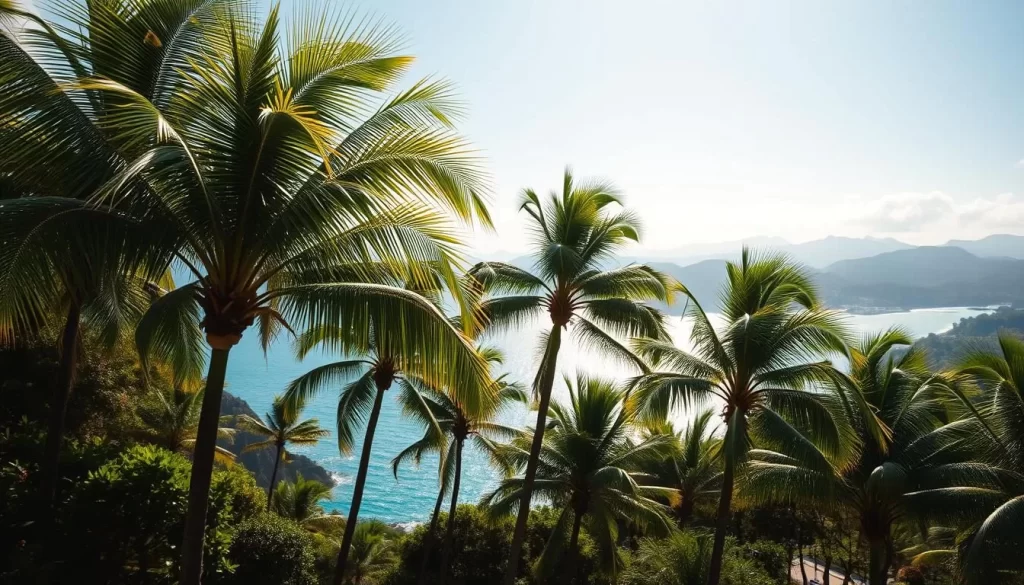
Temperature Variations Throughout the Year
Okinawa’s temperature variations are less extreme compared to mainland Japan. Winter lows rarely drop below 59°F (15°C), while summer highs can reach into the mid-80s°F (around 30°C). This makes Okinawa a favorable destination for those seeking milder winters and warm summers.
Rainfall and Humidity Considerations
The rainy season in Okinawa typically runs from early May to mid-June, bringing increased humidity and regular rainfall. Understanding this pattern can help you plan your outdoor activities. The rest of the year is relatively dry, making it ideal for exploring the islands.
Typhoon Season: What You Need to Know
Okinawa’s typhoon season usually occurs from June to October. Typhoons can bring heavy rain, strong winds, and flooding risks, potentially disrupting your travel plans and outdoor activities. Being aware of this season is crucial for planning a smooth trip.
| Season | Temperature Range | Weather Characteristics |
|---|---|---|
| Spring | 65-75°F (18-24°C) | Mild, occasional rain |
| Summer | 80-86°F (27-30°C) | Hot, humid, rainy season |
| Fall | 70-80°F (21-27°C) | Comfortable, typhoon risk |
| Winter | 59-68°F (15-20°C) | Mild, dry |
Spring in Okinawa: March to May
Spring is a fantastic time to visit Okinawa, offering a mix of cultural experiences, outdoor adventures, and stunning natural beauty. During these months, the weather is particularly pleasant, making it ideal for exploring the islands.
Weather Conditions and Temperature Ranges
Okinawa’s spring weather is characterized by mild temperatures and relatively low humidity, creating a comfortable environment for tourists. Temperatures gradually rise from March to May, ranging from approximately 17°C to 23°C (63°F to 73°F).
Cherry Blossom Season in Okinawa
The cherry blossom season in Okinawa is a significant attraction, with the cherry blossoms blooming earlier than in mainland Japan, typically from late January to February, and sometimes again in late March. This unique timing allows visitors to enjoy the blossoms before the crowds arrive on the mainland.
Spring Festivals and Activities
Spring in Okinawa is not just about the cherry blossoms; it’s also a time for vibrant festivals and outdoor activities. Visitors can enjoy hiking through lush forests, participating in local adventure sports, and experiencing the rich cultural heritage through traditional music, dance, and food festivals.
As you plan your visit, consider that early May can be an excellent time to enjoy Okinawa before the rainy season begins, though it can get crowded due to Golden Week.
Summer in Okinawa: June to August
If you’re planning to visit Okinawa during the summer, be prepared for a mix of intense heat and exciting outdoor activities. Summer is a vibrant season in Okinawa, filled with cultural events, beach fun, and warm weather that attracts visitors from around the world.
Heat, Humidity, and Rainfall Patterns
Okinawa’s summer is known for its hot and humid weather, with temperatures often reaching the mid-80s Fahrenheit. The high humidity can make the temperature feel even hotter. It’s also a period of occasional rainfall and potential typhoons, but many summer days are perfect for enjoying the outdoors.
Beach Activities and Water Sports
Summer is the best time to visit Okinawa’s stunning beaches and enjoy various water activities. You can indulge in snorkeling, diving, and swimming in the crystal-clear waters surrounding the islands. Many tour operators offer exciting water sports and island-hopping experiences, making it a great time for beach adventure.
Summer Festivals and Cultural Events
Despite the heat, summer is a great time to experience Okinawa’s vibrant cultural festivals and events. The summer solstice is a significant event, marked with traditional dances and meetups. You can immerse yourself in the local culture and enjoy the tropical climate, making for a memorable summer experience in Okinawa.
To make the most of your summer visit, be sure to book your accommodations in advance due to the significant crowds during Japanese school holidays. While typhoons are a possibility, many days offer perfect weather for outdoor activities and cultural experiences.
Fall in Okinawa: September to November
Experience the best of Okinawa during the fall, a season that balances pleasant weather with fewer crowds and rich cultural experiences. The fall season in Okinawa, spanning from September to November, is characterized by a gradual transition towards cooler temperatures, making it an ideal time to explore the islands’ natural beauty and cultural heritage.
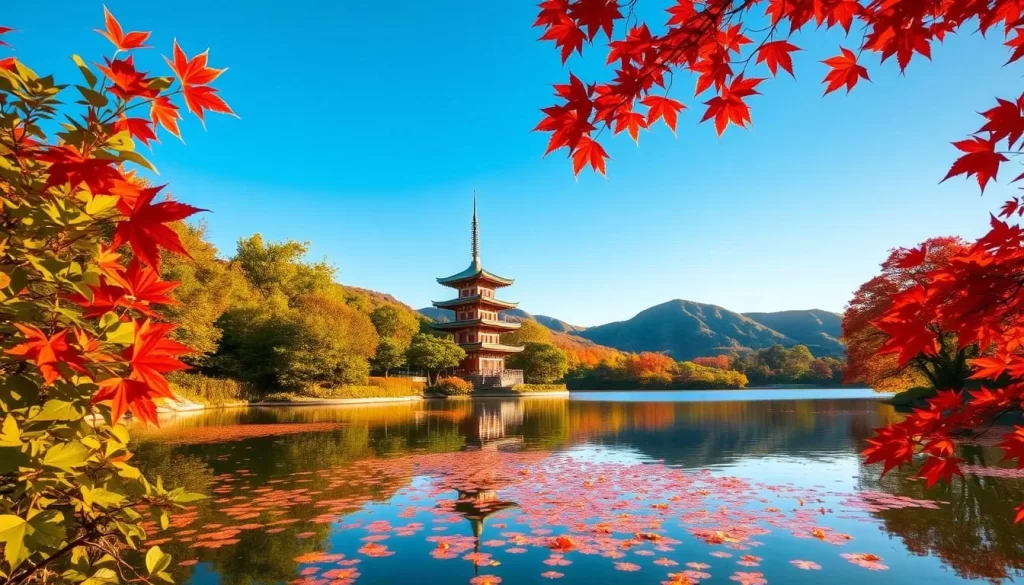
Weather Transition and Temperature Drops
The weather during Okinawa’s fall season undergoes a pleasant transition, with temperatures gradually decreasing and humidity levels dropping, making outdoor exploration more comfortable. By November, the temperatures have cooled down significantly, offering a welcome respite from the summer heat.
Outdoor Activities and Natural Beauty
Fall is a great time to enjoy Okinawa’s outdoors, with comfortable temperatures ideal for hiking, exploring remote beach areas, and engaging in various outdoor activities across the archipelago. The natural beauty of the islands transforms subtly during autumn, with certain trees and plants changing colors, adding to the landscape’s visual appeal.
Fall Cultural Experiences and Festivals
Okinawa’s fall season is rich in cultural experiences, including harvest festivals, traditional performing arts events, and culinary celebrations that showcase the islands’ unique food culture. You can enjoy dishes made from fresh, locally sourced ingredients, highlighting the season’s rich crops and the local culinary expertise.
Some of the key highlights of visiting Okinawa in the fall include:
- Pleasant weather with gradually decreasing temperatures and humidity levels
- Fewer crowds compared to the peak summer season
- Rich cultural experiences, including harvest festivals and culinary celebrations
- Excellent opportunities for outdoor activities like hiking and exploring remote beach areas
Winter in Okinawa: December to February
You can enjoy a warm and mild winter in Okinawa, unlike many other parts of Japan. The subtropical climate of the islands makes them an ideal destination for those seeking to escape the cold.
Mild Climate Compared to Mainland Japan
Okinawa’s winter, spanning from December to February, is surprisingly mild, with temperatures in Naha ranging between the high 50s to low 70s Fahrenheit (15-21°C). This makes it a great time to visit when other areas are chilly.
Winter Activities and Attractions
During the winter months, you can enjoy various activities such as hiking in comfortable temperatures, exploring indoor attractions, and visiting less crowded beach areas in the southern regions. The clear skies and excellent visibility also make it an ideal time for snorkeling and exploring Okinawa’s natural beauty.
Whale Watching and Marine Life
Winter is the best time for whale watching in Okinawa, as humpback whales migrate to the warm waters around the islands. This offers spectacular opportunities to observe these magnificent creatures. Additionally, Okinawa’s cherry blossoms bloom during winter, typically from late January through February, providing a unique experience without the massive crowds seen in other parts of Japan.
The winter season in Okinawa offers a different perspective on the islands’ natural beauty, with unique flowering trees and plants not seen in other seasons. Despite being the coolest time of year, the pleasant weather conditions allow for outdoor exploration across most places in the islands.
Best Months for a Weather-Savvy Trip to Okinawa
Okinawa’s subtropical climate means that the island has distinct seasons, each offering different advantages for travelers. Understanding these seasonal variations is key to planning a trip that meets your preferences for weather, activities, and crowd levels.
Late April to Early May: Perfect Balance
Late April to early May is considered one of the best times to visit Okinawa. The weather is mild and pleasant, making it ideal for outdoor activities. Although it’s worth noting that this period coincides with Golden Week, a peak travel season in Japan, which might attract larger crowds.
October to November: Ideal Fall Experience
October to November offers an ideal fall experience in Okinawa. The temperatures are comfortable, humidity is low, and the crowds have dissipated since the peak summer months. This makes it an excellent time for enjoying the island’s natural beauty and outdoor activities.
February to March: Off-Season Benefits
For those looking for a more budget-friendly trip, February to March can be an attractive option. Hotel rates are lower, and the crowds are significantly smaller. Additionally, this period offers a unique opportunity to see cherry blossoms in bloom, months before they appear in mainland Japan.
Here’s a summary of the best times to visit Okinawa and what you can expect:
| Time of Year | Weather | Crowds | Activities |
|---|---|---|---|
| Late April to Early May | Mild and pleasant | Moderate to High | Outdoor activities, cultural experiences |
| October to November | Comfortable temperatures, low humidity | Fewer crowds | Outdoor activities, natural beauty |
| February to March | Cooler temperatures | Fewer crowds | Cherry blossoms, off-peak rates |
By understanding the advantages of each season, you can plan your trip to Okinawa at the best time for your preferences, ensuring a memorable and enjoyable experience on this beautiful island.
Avoiding Typhoon Season in Okinawa
To have a weather-savvy trip to Okinawa, understanding and avoiding the typhoon season is essential. Okinawa’s geographical location makes it prone to typhoons, which can bring heavy rain, strong winds, and flooding risks, potentially ruining your outdoor activities and travel plans.
Understanding Typhoon Patterns and Risks
Okinawa’s typhoon season typically runs from June to November, with the peak activity usually occurring in August and September. The islands are vulnerable to typhoons, with an average of 7-8 typhoons affecting Okinawa each season. Although not all make direct landfall, it’s crucial to be aware of the risks and monitor weather forecasts closely.
- The frequency and intensity of typhoons can vary significantly from year to year.
- Typhoons can develop quickly and change direction unexpectedly, making it essential to stay informed.
Contingency Planning for Typhoon Season Travel
If you must travel during typhoon season, consider purchasing travel insurance that covers weather-related cancellations and delays. Local businesses and tour operators are experienced with typhoon preparations and can provide valuable guidance on safety measures during your travel time in Okinawa.
| Month | Typhoon Risk Level | Precautions |
|---|---|---|
| June | Moderate | Monitor weather forecasts |
| August | High | Consider travel insurance |
| November | Low | Stay informed about weather updates |
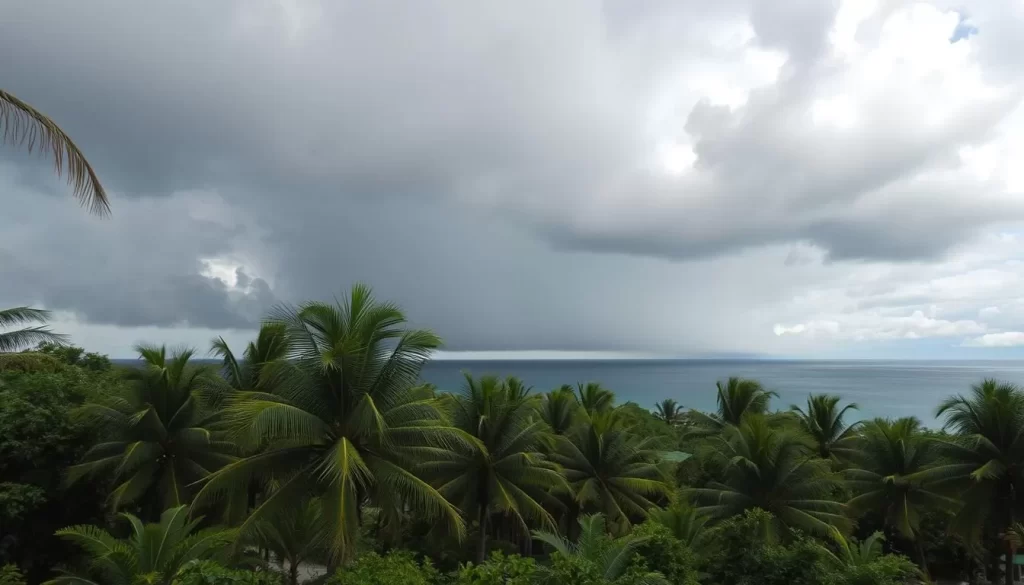
Navigating Okinawa’s Rainy Season
Understanding Okinawa’s rainy season is crucial for travelers to make informed decisions about their trip. The rainy season, which typically occurs from early May to late June, brings significant rainfall and increased humidity to the islands.
When and How Long It Lasts
Okinawa’s rainy season usually begins in early May and continues through late June. During this time, the islands experience regular rainfall, with the amount varying significantly from day to day and across different parts of Okinawa. It’s essential to stay updated on the weather forecast to plan your activities accordingly.
Indoor Activities and Rainy Day Plans
Despite the rain, there are plenty of indoor activities to enjoy in Okinawa. You can explore the fascinating museums, participate in traditional craft workshops, or visit unique shopping districts. The lush life and vibrant plant life that the rainy season brings also make it an excellent time for nature lovers to appreciate the islands’ beauty.
Navigating the rainy season successfully requires flexibility and having alternative plans ready. With good air conditioning in your accommodations and a mix of indoor and outdoor activities, you can enjoy your trip to Okinawa even during the rainy months.
Packing Tips for Different Seasons in Okinawa
Packing for Okinawa requires a thoughtful approach, taking into account the season and activities you have planned. Understanding the weather and local customs will ensure you’re prepared for a comfortable and enjoyable trip.
Essential Items Year-Round
Regardless of the season, there are certain essentials you should always pack. These include sun protection (sunscreen, hats, shades), comfortable walking shoes for hiking and exploring, and swimwear for enjoying the beautiful beaches.
Seasonal Clothing and Gear Recommendations
For summer, prioritize lightweight, breathable clothing and extra sun protection. In winter, pack light layers for cooler mornings and evenings. Adventure activities like hiking, snorkeling, or diving may require specialized gear, which can often be rented locally.
Sun Protection and Weather-Related Accessories
Sun protection is vital year-round in Okinawa. Don’t forget to pack sunscreen with a high SPF, a hat, and sunglasses. For occasional summer showers, a light rain jacket is also a good idea.
| Season | Clothing | Accessories |
|---|---|---|
| Summer | Lightweight, breathable | Sunscreen, sunglasses, light rain jacket |
| Winter | Light layers | Sun protection, comfortable shoes |
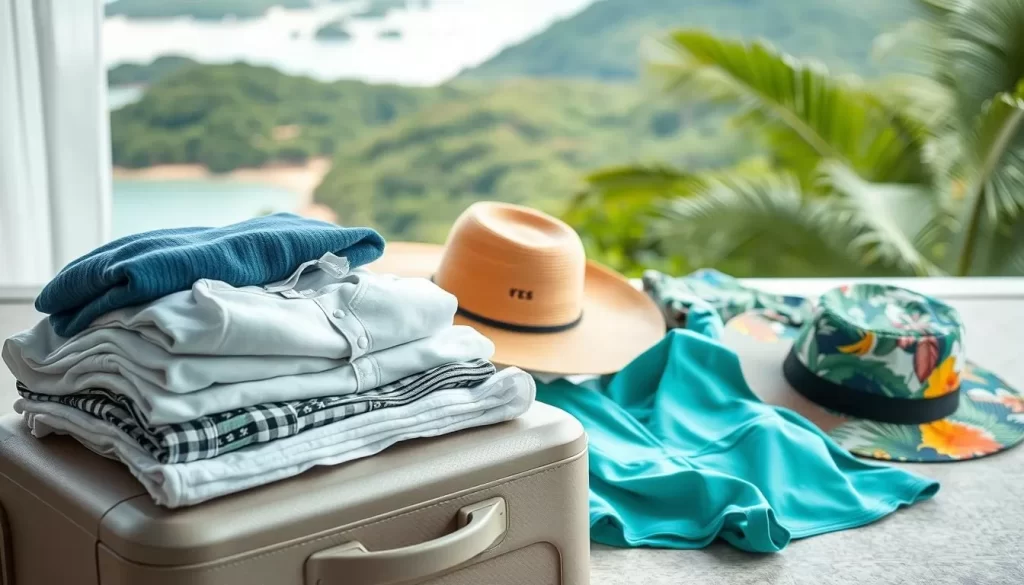
Conclusion
Whether you’re drawn to Okinawa’s beaches, culture, or natural beauty, the right time to visit can elevate your trip. With a comprehensive understanding of Okinawa’s climate patterns and seasonal variations, you’re now equipped to plan a weather-savvy trip that aligns with your preferences.
The spring season offers a unique experience with early cherry blossoms and pleasant temperatures, while summer provides a quintessential tropical island experience despite the heat and crowds. In contrast, fall or autumn presents balanced weather conditions with comfortable temperatures and fewer crowds, making it an ideal time for many travelers.
Winter in Okinawa remains mild compared to mainland Japan, offering a pleasant escape with unique seasonal activities. By considering the information in this guide, you can confidently choose the best time to visit Okinawa that suits your travel style and preferences. This knowledge will help you make the most of your time in Okinawa Prefecture, ensuring a memorable experience in this unique Japanese destination.
Now, you’re ready to plan your trip to Okinawa, armed with the knowledge of the season that best fits your travel plans, allowing you to fully enjoy the area’s natural beauty and cultural heritage.
The above is subject to change.
Check back often to TRAVEL.COM for the latest travel tips and deals.






